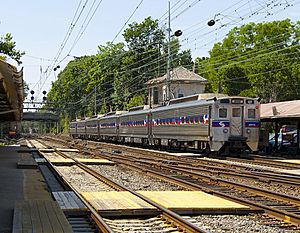Paoli/Thorndale Line facts for kids
Quick facts for kids Paoli/Thorndale Line |
|
|---|---|

A westbound Paoli/Thorndale Line train departing from the Bryn Mawr station.
|
|
| Overview | |
| Status | Operating |
| Termini | Temple University Thorndale |
| Stations | 26 |
| Website | septa.org |
| Service | |
| Type | Commuter rail |
| System | SEPTA Regional Rail |
| Operator(s) | SEPTA Regional Rail |
| Rolling stock | Electric Multiple Units |
| Daily ridership | 24,018 |
| Technical | |
| Track gauge | 4 ft 8 1⁄2 in (1,435 mm) standard gauge |
| Electrification | Catenary |
The Paoli/Thorndale Line is a train route that helps people travel around southeastern Pennsylvania. It is part of the SEPTA Regional Rail system. This train line runs from the big city of Philadelphia all the way to Thorndale in Chester County, Pennsylvania. It's a very important way for thousands of people to get to work, school, or visit friends and family every day.
Contents
What is the Paoli/Thorndale Line?
The Paoli/Thorndale Line is a busy train route operated by SEPTA, which stands for the Southeastern Pennsylvania Transportation Authority. It's one of many train lines that connect Philadelphia with its nearby towns and suburbs.
This line is used by many people who live outside the city but work or study in Philadelphia. It also helps city residents travel to the suburbs. The train makes 26 stops along its route, making it easy for people to get on and off at different locations. On an average day, over 24,000 people ride this train!
Where Does the Line Go?
The Paoli/Thorndale Line starts at Temple University in Philadelphia. From there, it travels west through many towns. Its final stop is in Thorndale, Pennsylvania. This route covers a good distance, connecting urban areas with more rural ones.
How Do These Trains Work?
The trains on the Paoli/Thorndale Line are called Electric Multiple Units (EMUs). This means they are electric trains that get their power from overhead wires. These wires are called a "catenary" system. The trains collect electricity from these wires to move.
The tracks the trains run on have a specific width, called a "gauge." For this line, the tracks are standard gauge, which is 4 feet, 8.5 inches wide. This is a common width for train tracks around the world.
History of the Paoli/Thorndale Line
The Paoli/Thorndale Line has a long and interesting history. Much of its route follows tracks that were originally built by the Pennsylvania Railroad. This was one of the largest and most famous railroads in the United States.
The Main Line and Keystone Corridor
A big part of the Paoli/Thorndale Line runs along what is known as the "Main Line." This historic railway section was very important for connecting Philadelphia with the western parts of Pennsylvania. Today, SEPTA trains share these tracks with Amtrak trains, which are long-distance passenger trains. This shared section is part of the "Keystone Corridor," a major rail route.
Important Stations Along the Way
Some stations on the Paoli/Thorndale Line have been around for a very long time.
- Paoli Station: This is a major stop and a very busy station. It's a key transfer point for many travelers.
- Radnor Station: The Pennsylvania Railroad opened Radnor station way back in 1872. This shows how old and established some parts of this train line are. These stations have served communities for over a century!
Why is This Line Important Today?
The Paoli/Thorndale Line plays a vital role in daily life for many people.
- Connecting Communities: It links many towns and cities, making it easier for people to travel for work, school, or fun.
- Reducing Traffic: By taking the train, many people avoid driving cars. This helps to reduce traffic jams on roads and highways. It also helps the environment by lowering car emissions.
- Part of a Bigger System: The Paoli/Thorndale Line is just one part of the large SEPTA Regional Rail network. This network helps millions of people move around the greater Philadelphia area every year.
Images for kids




